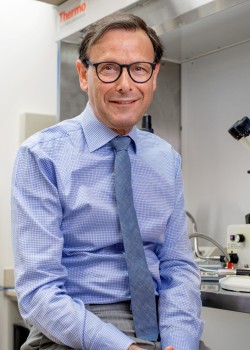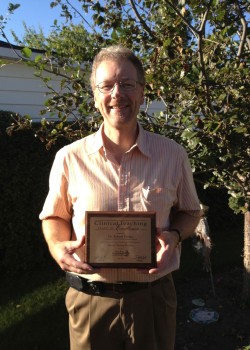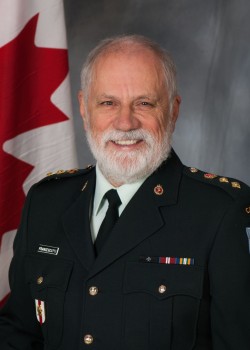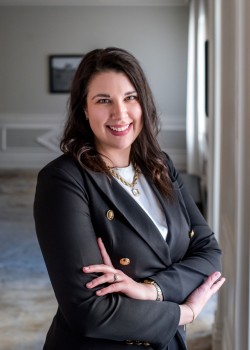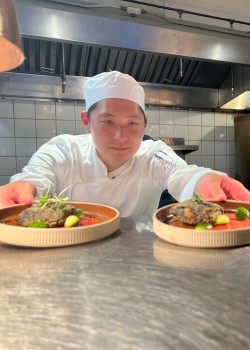My medical story is not the usual one. Perhaps that is why I was added to the list of 50. In my case it has both vocational and avocational elements to it. Notwithstanding, a reader researching medical career paths would find my book on Alberta’s Medical History. Young and lusty and full of Life a worthwhile reference as well, as it outlines the lives and careers of 35 prominent Alberta physicians and their significant contributions to medicine in Alberta and Canada.
My Journey toward Medicine:
I am an identical twin born in Red Deer in 1940. Both Doug and I became physicians. We were from a family of eventually five boys that included another physician, an MBA/Engineer and an Optometrist. Both of our parents were Optometrists who practiced together in Red Deer for 110 years. So choosing a career in health care was in our genes.
Our parents were strong proponents of a university education. They gave us the freedom to make the final selection of our careers on our own, but there was no question about going.
They did, especially father, infuse us with an appreciation for hard work, paying our own way and saving well before university. At the time only 12% of Grade 1 students went to university, a figure that is now about 4x higher.
The first career determinant for me came while attending a high-quality high school - Lindsay Thurber in Red Deer. It provided academic, technical, and skill teaching courses, and was large enough to allow us to participate in most sports particularly ones that could be enjoyed for a life time.
Choosing Medicine:
Although many classmates mention their how their family physician was their role model, our family had multiple physician friends, but none filled that role. There were only a couple of specialists in town. With no career designs in mind, leaving home to go to university became an advantage as you lived in residence, could walk to class, and could participate in the extracurricular activities on campus including frats.
My first thought about taking medicine came towards the end of my first year. My aunt in Edmonton was also an optometrist. She had worked for a time in San Francisco in an office with ophthalmologists. I found that interesting as it provided an opportunity to take it and return to Red Deer years later. However, the relationship between the two professions was not the greatest at the time. In looking back, optometry would have been a much more profitable choice as you could increase your income through the sale of glasses, but not as an ophthalmologist as it was deemed unethical! This possible career choice did influence my fourth year study habits as I spent extra time cramming for the EENT final exam, achieving the top class mark, but suffering by not giving enough time to the national exam courses, paying the price for it in my overall marks.
Challenges and Growth:
One experience enshrined in my memory is about the way we were taught medicine. The early years were very memorizing orientated. Only in fourth year do I remember vividly a case of a breast carcinoma at the Royal Alex where the admitting history was succinctly written, covered the signs and symptoms leading to the diagnosis, the physician’s examination of the mass for the possibility of spread and the preoperative fitness for anesthesia. The summary was brief, focused, told the story succinctly, logically, and didn’t spend time detailing the whole-body examination as we had been taught. Nor were we taught one body system at a time or how to integrate our knowledge, recording only that which was relevant. Critical thinking was missing.
The concept that what was common in medicine is very common, was missing as well. Since 1970 teaching in the Calgary program has been focused on one body system at a time. Teaching by deductive reasoning starts with the 120 commonest diagnoses.
Impact on your Career:
One reason I took medicine was because it gave me another four years to make a final decision about what I wanted to do/be. The two most significant events that guided me in that decision came during fourth year and shortly after my final exams. My medical classmate and cadaver partner had twisted my arm to join the student Promotions Committee which he chaired in our third year. When he didn’t wish to continue, he asked me to take over. Although it would be during my last year, I put my name forward and the Students Council accepted me, with reservations about the time I would have.
Well, the year turned out to be very unplanned, but exciting. The UofA Golden Bears won the Western University football league while the Queens Golden Gaels did the same in central Canada creating an opportunity for a postseason ‘playoff’ game. A $5.00 phone call secured a positive response from Queens to come west for it. The unexpected result came when the Alberta team won the game in front of their 9000 fans. It just happened that my girlfriend and future first wife was from Queens. The success of the game started what is now the Vanier Cup. There were multiple other events we organized that year all of which cut into my what should have been study time. It was compounded by writing 21 exams in 23 days at the end which was exhausting.
Then, while visiting my girlfriend after graduation in Toronto, I was introduced to a neighbour who was the Medical Director of the St. Michaels hospital and had a MD and an MBA. He was the first in Canada. His example convinced me that if I didn’t find a specialty I liked here was an alternative.
To shorten the story, I enjoyed every service I was on, which made choosing a specialty difficult. I was offered a year of clinical research in Surgery following a rotating internship. My surgical year was interesting because it involved investigating patients that were in ‘shock’, a predecessor to the creation of ICUs. Halfway through the year I decided the MBA would be my specialty of choice as it was only two years and the failure rate wasn’t 50% like it was in most specialties. So, I applied to the Ivey Business school in UWO and they accepted me, their third MD/MBA student. Their program was based on the case study method, distantly akin to medicine. It also allowed me to finish my MSc. and write a major paper on the organization and delivery of health care in Canada, through the UWO medical school. I would learn to read balance sheets and later help turn the family company around.
Then I went looking for a job. After extensive interviews mostly in Toronto I received two offers in one weekend. One was as the Medical Director of the new and partially opened Foothills Hospital in Calgary. This meant coming home which made the decision easy. My responsibilities included negotiating the annual salary schedule for the Residents with PAIRA in the early 1970s. I was at the Foothills for 11 years before realizing that health care costs were growing at twice the rate of inflation and that was not going to last. So, I left to take my postponed decision to study Ophthalmology at McGill. It was a like a second residency. I thoroughly enjoyed it but realized my heart and head were still in management and it would be years before I could even start to build a practice.
When an opportunity to re-enter management as the Medical Director of the large Michener Center in Red Deer came open, I moved back to join the family. I had worked there after Med 3. At Michener I was able to develop quality assurance programs that minimized psychotropic drug overuse, validated their effectiveness, introduced new drugs, manage over 100 staff and developed an award-winning medical information system.
My Avocation: One extracurricular experience in Calgary had been to spend an evening every two weeks with Dr. Earle Scarlett who had been on the Foothills Board. He was a retired cardiologist and the most prolific medical and medical historical writer in Canada since Sir William Osler. One story he told was about the lecture he received while a student at the UofT, on the difference between vocations and avocations. Vocations he said were a means to an end. The end was your avocation. His own life had evolved from his career in medicine to medical history. Such a capable writer, he and a colleague persuaded his clinic to sponsor a quarterly medical historical journal, which he edited for 22 years. As well he wrote over 500 other articles that included writing in three medical journals simultaneously.
After I incurred a knee injury and thought my mountain scrambling and curling days were over, Dr. Scarlett encouraged me to read about the Canadian Rockies where he had done much of his summer writing. I did and began accumulating books on the Rockies and Prairies, especially on medicine in Alberta. It turned out to be a topic only addressed through interviews and articles in his own journal. With little written since the 1950s, there obviously was a vacuum. Then I was appointed to the AMA’s Archives Committee, a relationship that would last for the next 38 years. They asked me to write some articles for the Alberta Doctors Digest.
First, I needed to establish a library. After that, articles on interesting medical topics followed. So did books on prominent physicians in Alberta’s history, the Deans of Medicine at the UofA, the Cardiovascular Sciences in Calgary and the history of the Cumming Faculty of Medicine all of which led to the discovery that Medicare in Canada started In Alberta, not Saskatchewan.
Looking ahead: Medicine is a naturally satisfying profession. Each patient is intellectually challenging as the physician seeks to discover and treat the reasons for their visit and then guide them through the healing process. As Osler said you have to continue to learn all your life. It is not dull. Compare that with accounting or other repetitive careers. Each day something new is learned.
I don’t have an abundance of wisdom for discerning the future of residency training in Alberta. The Canadian system of training is well known and the graduates highly respected worldwide. Many of the improvements in medical education have come from Canada. I do hate to see the graduate and undergraduate programs never getting shorter. Some are very reliant on apprenticeship learning. Now you don’t start earning money until you are almost 30. When you do, young family practitioners attract patients close to their own age. You grow older with them, and there comes a breaking point at the end of your career.
Personal Legacy and Future Vision: My proudest accomplishment have been outside Medicine, in the history field. I love taking a historical topic or discovery and giving it currency. Nominating colleagues for awards they deserve and meeting their families has been rewarding. I believe the profession is under acknowledged and yet so full of very bright and talented members. It has changed though. When I started there was no Medicare and one doctor for 1000 patients. Now it is 1 for 500, a change the government funders don’t wish to recognize.
My interest in history extended to the local Red Deer Rotary club. After I joined it, I discovered that it was Canadians who made Rotary International, and Canadians were the leaders in extending it around the world. That is another under told story, about the Calgary Rotarian who chartered the Red Deer club. He went on to form Rotary clubs around world and had a prominent mountain named after him which was never added to the map until I discovered the error.
For more please read my book on Alberta’s Medical History.
Note: Dr. Robert Lampard’s story is presented in his own words and in first person, allowing readers to experience his journey and reflections exactly as he shared them.

